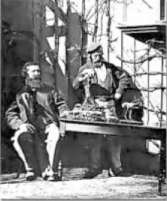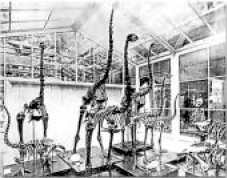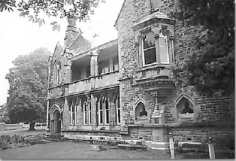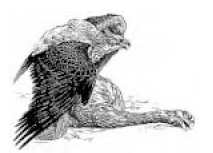Frederick Richardson Fuller 1830 - 1876

Julius Haast (sitting) and Frederick Fuller in Dr A C Barker’s garden.
In the 1860s Canterbury Provincial Geologist Julius Haast (later Sir Julius von Haast) strove to broaden the minds of the Christchurch citizenry by establishing a substantial museum in its midst. For a decade, his key subordinate was Frederick Richardson Fuller.
Born in Suffolk, England about 1830, Frederick Fuller was the son of Sarah Richardson and her husband, Frederick Fuller, a gentleman. At some stage Frederick junior trained as a taxidermist. On 10 February 1849, on the barque Candahar, he arrived in Adelaide, South Australia, subsequently working at Beautiful Valley near Mount Remarkable as a farmer and hotelkeeper. On 10 December 1859, Frederick Fuller, 29, married Mary McGrath, 18, at Well Hut, Pekona, probably the residence of the bride’s father, Matthew McGrath. The McGraths appear to have been Irish Catholics of humble station. The bride wrote her name but the witnesses, Bridget Ryan and Patrick McGrath, a shepherd, were illiterate, signing with their mark “X”.
In 1862, Frederick gave up the licence of the Roundwood Inn in Beautiful Valley. Soon after the family moved to Otago, Frederick describing himself as a miner. On 5 May 1863 he bought, for £60, a “dwelling-house and land” in Maclaggan Street, Mornington, Dunedin. According to Julius Haast, Frederick “set up the collection of New Zealand birds for the Otago Government”. This was probably part of the “botanical, ornithological and conchological” material of Dr James Hector, which was displayed at the beginning of 1865 at the International Exhibition in Dunedin.
Frederick sold his property on 6 March 1865 for the sum which it had cost him1, and, with a renewed interest in the profession for which he was trained, offered his services to Haast. He had a very uncertain contract - on 3 August the provincial government provided Haast with the measly sum of £25 for salary and equipment - and laboured in cramped quarters in the north-eastern corner of the provincial council chambers. These rooms housed an embryonic museum which included not only the natural history offerings of local enthusiasts but also the skins of rare birds which Haast had gathered when exploring remote areas.
By Christmas Frederick had set up 130 specimens. Further public funds became available and Haast’s creation, the Philosophical Institute of Canterbury2, also chipped in. Frederick was to state publicly that, without the institute’s support, he would have been forced to seek employment in other provinces.
The taxidermist accompanied Haast on expeditions to the province’s north-eastern portion, Mount Cook and the headwaters of the Rakaia, his mission to retrieve examples of the province’s previously neglected common bird life, including nests and eggs. Haast was able to proclaim: “With a few exceptions, all the birds inhabiting this part of New Zealand are now represented in the collection by good stuffed specimens”. In April 1866 Haast made his first major overseas exchange, sending bird skins to famed naturalist Professor Louis Agassiz, whose museum was at Cambridge, Massachussetts.
From December 1866 the Glenmark swamp yielded a mighty deposit of moa bones. Landowner George Henry Moore loaned his workmen and, under Haast’s direction, the first portion of the haul was excavated and brought to Christchurch on a large American four-horse wagon. When moa bones had been discovered elsewhere in the country, they had been sent to museums at London and Oxford. Haast determined that, in return for examples of the wildlife of America and Europe, he would send much of the new find to museums in these regions.

Glenmark moa skeletons articulated by F R Fuller: Weekly Press, December 1900, p27
The taxidermist and his superior found that, often, 25 to 30 moa specimens were so closely packed together that the whole formed one mass. Nevertheless, the pair sat on the bank of the Avon, sorting the bones into different sub-species and then into individuals. It soon became obvious that, for the find to be shown off to best effect, new quarters would be required. Haast succeeded in taking over for museum purposes an attractive provincial council room on the first floor of “Bellamy’s”, the stone structure in the provincial council complex which stands adjacent to the Great Hall and looks over the river. The museum headquarters, commonly known as the “coffee room”, would one day become the Superintendent’s office. The adjacent room - small and with a fine bow window - was Frederick’s work space. Using the contents of the original four-horse wagon and working in the “coffee room”, the taxidermist articulated Canterbury’s first seven moa skeletons. When, in December 1867, the museum was opened to the public, these became a source of wonderment to the populace. For years they were “admitted to be the finest representative collection in the world”.

'Bellamy's', Canterbury Provincial Council complex. The room with the bow window was Frederick Fuller's work space.
In 1870, the great animal, vegetable and mineral collection was made readily accessible to the public in the purpose-built stone museum in Rolleston Avenue. The staff consisted of “a director [Haast] … taxidermist [Frederick] and a boy on a temporary engagement”. For a time trustees ran the museum, after which management was handed to the Board of Governors of Canterbury University College. From 1874, Frederick’s name was included, along with that of the director, in the annual Southern provinces almanac. The taxidermist also figured prominently in photographs on show at the museum. In one image he appeared with bushy beard, moustache and long soft flowing hair, a “figure out of the Ober-Ammergau passion play in mufti”. In another, he stood inside a whale skeleton. In awe did a child ask: “Mama, is that Jonah in the whale’s belly?” More importantly, Frederick received the respectable salary of £200 per year.
Frederick undertook a variety of tasks. When Haast was ill, he secured the skeleton of a stranded whale and made the necessary observations as to its dimensions, form, sex and age. When runholder and conservationist Thomas Henry Potts discovered a new species of gull, Frederick, hot on his heels, found specimens near the mouth of the Waimakariri. At Little Rakaia, Frederick and Haast examined the cooking places and kitchen midden of the moa hunters. Frederick excavated in and about the ancient Maori encampment at Moabone Point, Sumner, transferring to the museum, articulating and putting on display a human skeleton which was found at the site.

Harpogornis atop a slain moa. From Richard Holdaway's Terror of the forests, New Zealand geographic, October/December 1989, p56
Frederick’s major achievement was the discovery and identification of harpagornis, the New Zealand eagle. On Sunday 26 March 1871, at Glenmark, the taxidermist was supervising an excavation five to six feet below the swamp. There, over an area of 30 feet square and among a quantity of moa remains, were found, in an excellent state of preservation, a few smaller bones. These - a femur, rib and two claws - Frederick at once deduced to be from a giant bird which preyed on and died with a swamp-stuck moa. Some time later, further bones from the same skeleton were discovered.
Newspapers - practical organs giving voice to work-a-day issues - made passing reference to the discovery. However, Haast wrote it up in an article in the Transactions of the New Zealand Institute. Fearing that a vessel might be lost on the voyage to England, the museum director stated that he would depart from the practice of sending the bones to an overseas anatomical expert. Instead, he would honour the Glenmark landowner by calling the bird harpagornis moorei and have Frederick Fuller articulate his find.
Haast, impressed with the enormous strength of the feathered moa hunter, commented that, of contemporary carnivorous mammals, only the lion and tiger possessed stronger claw bones. Research has shown that harpagornis dwelt in the South Island’s shrub land and forest. It scooped up unsuspecting geese, and struck down 250 kilogram adult moa, the tallest bird ever to have existed. Not only was harpagornis the top carnivore in the early New Zealand food chain, it was also the world’s largest eagle and the largest bird of prey, bigger even than its cousins, the Philippine eagle and Andean condor. He reigned supreme for thousands of years prior to the coming of the Maori. In vestigial Polynesian legend he was “te hokioi”, the name being based on his cry, “Hokioi, hokioi, hu”, which was feared as a portent of war. However, he lacked adaptability, becoming extinct a few centuries after man’s arrival when the common food supply, the moa, was wiped out.
Frederick Fuller was a family man. Children were born to Mary and Frederick in South Australia, Otago and Christchurch; eventually there were five sons and two daughters. Some of the children - Frederick and John, for example - were baptised in both Catholic and Anglican churches. However, after settling in Avonside, the family became associated with Holy Trinity Anglican church. John, Thomas and Mary were baptised there in 1869, followed two years later by Sarah.
Although but a skilled servant, Frederick moved easily among the intellectuals of the colonial gentry. Haast often acknowledged his technical skill and immense loyalty. Early on he stated: “We could not find a more hardworking or useful man than Mr Fuller who has hitherto performed his duties to everybody’s satisfaction”. He informed his superiors: “I cannot dismiss Mr Fuller who has worked day and night indefatiguably [sic]…” Much later he mentioned the taxidermist’s “perseverance… assiduity… [and] real enthusiasm’; and how “Mr F R Fuller… has continued to labour with the same energy as for years past”.
Alas, Frederick was subject to depression and over-fond of alcohol; a son was to state that he got intoxicated once or twice a week. He drank on the job and, eventually, in July 1876, the usually kind-hearted Haast fired him. Seeking an investigation into the causes of his dismissal, Frederick addressed a mildly worded “appeal to the public of Christchurch” but the newspapers refused to publish it. In “a low state of mind” the unfortunate man entered the workshop behind his home and there consumed arsenic which he had used in his employment. An unco-operative patient, he frustrated a doctor’s attempts to pump the poison from his body. On 28 July he died.
Frederick left “a wife and five young children very poorly provided for”. By five votes to four and with the chairman abstaining, the Canterbury College Board of Governors carried a motion that Mary should be granted two months of her husband’s salary. It was necessary that the amount be taken from the first money accruing to the museum “as the balance to the credit of that institution at present amounts to the magnificent sum of five shillings and three pence.” Haast collected funds for the family of his deceased subordinate. As well, he completed formalities which gave Mary secure title to land in Haast Street, part of Rural Section 29, for which Frederick had paid 300 pounds in 1873. The property was a small part of the museum director’s estate, “Gluckauf”.
Frederick Richardson Fuller lies in the Avonside churchyard with his son, Thomas. Mary Fuller died in 1918. She and her unmarried daughters, Mary and Sarah, were true to their faith. They are buried in the Roman Catholic portion of the Linwood Cemetery. Despite the praise of Julius Haast, people forgot Frederick’s work. Even museum staff long recounted a mangled version of how the taxidermist died, suggesting that he had hanged himself in the museum tower and that, ever after, his ghost haunted the older parts of the building.
Footnotes
- 1 Jane Smallfield conducted an extensive search in Otago documents. This revealed nothing on Frederick’s work. However, the Canterbury Provincial Government archives contain statements by Julius Haast about Frederick having articulated the bird collection of the Otago province.
- 2 This body of prosperous men with intellectual tastes was an ancestor of the Royal Society of New Zealand.
Sources
- Burdon, R M. New Zealand notables: series 3 (1950)
- Canterbury Provincial Council archives, Archives New Zealand, Christchurch
- Canterbury Museum. Material on F W Fuller supplied by Jo- Anne Smith
- Church register transcripts of baptisms, marriages and burials, Aotearoa New Zealand Centre, Christchurch City Libraries
- Fuller, Frederick Richardson and Mary McGrath. Marriage certificate held at Births, Deaths and Marriages Registration Office, Adelaide, South Australia
- Fuller, Frederick Richardson. Death certificate, Births, Deaths and Marriages, Christchurch
- Fuller, Frederick Richardson. Deceased estate, Archives New Zealand, Christchurch
- Fuller, Mary. Will, Archives New Zealand, Christchurch
- Greenaway, Richard. “Big bird”,Bookmark, July 1997, p5
- Haast, Julius. “Moas and moa-hunters”, Transactions and proceedings of the New Zealand institute, 1871, p66 - 90
- Haast, Julius. “Notes on Harpagornis Moorei, an extinct gigantic bird of prey”, Transactions and proceedings of the New Zealand institute, 1871, p192 - 6
- Haast, Julius. “Notes on Ziphius (Epiodon) novae-zealandiae, von Haast-goose-beaked whale”, Transactions and proceedings of the New Zealand institute,1879, p241 - 6
- Haast, Julius. “On Oulodon, a new genus of ziphioid whales”, Transactions and proceedings of the New Zealand institute, 1876, p450 - 7
- Haast, Julius. “On harpagornis, an extinct genus of gigantic raptorial birds of New Zealand”, Transactions and proceedings of the New Zealand institute, 1873, p62 - 75
- Haast, Julius. “On the early history of the Canterbury Museum”, Transactions and proceedings of the New Zealand institute, 1881, p503 - 16
- Haast, Julius. “On the measurements of dinornis bones, obtained from excavations in a swamp situated at Glenmark”, Transactions and proceedings of the New Zealand institute, 1868, p80 - 9
- Haast, Julius. “Researches and excavations carried on in and near the Moa-bone Point Cave, Sumner Road, in the year 1872”, Transactions and proceedings of the New Zealand institute, 1874, p54 - 85
- Haast, Julius von. Papers, Alexander Turnbull Library
- Hampton, Denis. Headstone transcripts, Holy Trinity churchyard, Avonside (1979)
- Holdaway, Richard. “Terror of the forests: giant eagle”, New Zealand geographic, October/December 1989, p56 - 64
- King, Michael. The collector: a biography of Andreas Reischek(1981)
- Lyttelton times, 2 July 1868, 21 March 1869, 29 March 1871, 31 July 1876, 1 August 1876, 26 September 1876
- Land Records, Land Information New Zealand, Christchurch
- Macdonald, G R. Macdonald dictionary of Canterbury biographies, Canterbury Museum Documentary History Department
- Potts, T H. “Notes on a new species of gull”, Transactions of the New Zealand institute, 1871, p203 - 4
- Press, 31 July 1876, 1 August 1876
- Smith, Jo-Anne. “Story of a ghost that never walked museum halls”,Press, 16 March 1989
- Southern provinces almanac, 1874 - 76
- Von Haast, H F. Life and times of Sir Julius von Haast, (1948)


 Discover your family’s history at our libraries
Discover your family’s history at our libraries